
The Imperial Guard of Napoleon III was a military corps in the French Army formed by Napoleon III as a re-establishment of his uncle Napoleon I's Imperial Guard, with an updated version of the original uniforms and almost the same privileges.

The Imperial Guard of Napoleon III was a military corps in the French Army formed by Napoleon III as a re-establishment of his uncle Napoleon I's Imperial Guard, with an updated version of the original uniforms and almost the same privileges.
The Imperial Guard was formed by a decree of the emperor on 1 May 1854, [1] and was made up of 17 regiments of cavalry, artillery and infantry, squadrons of train (supply and administration) and mounted gendarmes, and a division taken from the corps of military engineers. The emperor added a regiment of Zouaves to the Guard in 1855, selected from the three existing regiments of Zouaves first raised in 1830.

In its original 1854 structure the Imperial Guard comprised a mixed division of two infantry brigades (Grenadiers and Voltigeurs) plus one cavalry brigade of Cuirassiers and Guides. Additional units included two battalions of foot gendarmes, one battalion of Chasseurs a' pied, five batteries of Horse Artillery and a company of engineers.
During the 1860s the Imperial Guard was expanded to the size of a full army corps. This comprised the following divisions:
- 1st (Voltigeur) Division (four regiments of Voltigeurs plus one Chasseur battalion);
- 2nd (Grenadier) Division (three regiments of Grenadiers plus Guard Zouave regiment);
- Cavalry Division (comprised light brigade of Guides and Chasseurs; medium brigade of Dragoons and Lancers; heavy brigade of Cuirassiers and Carabiniers; and two batteries of Guard Horse Artillery);
- plus corps troops (four batteries of Horse Artillery, squadron of artillery train, squadron of regular train). [2]
Each of the two infantry divisions were given a Mitrailleuse company in the late 1860s.

The decree of 1 May 1854 establishing the Imperial Guard required line regiments to nominate experienced soldiers of good character for the new units. This followed the pattern established by Napoleon I, of creating a corps of veterans which could be relied on to provide an elite force that would provide a dependable reserve in battle and be politically loyal in peace. As the Guard was expanded some recruits had to be directly drawn from each annual intake of conscripts, to make up the numbers required. Guardsmen received higher rates of pay and enjoyed better conditions of service than their counterparts in other regiments. [3]

The Imperial Guard served with distinction in both the Crimean War and the Second Italian War of Independence of 1859, It did not participate in the Mexican Expedition of 1863-67 but remained on garrison duty in Paris. During the Franco-Prussian War of 1870 the Imperial Guard was present at the Battle of Mars-la-Tour, Battle of Gravelotte and the Siege of Metz. Although an elite corps which now numbered over 20,000, the Guard did not perform up to expectations in 1870. This was mainly due to poor judgement on behalf of its commanders, who at Mars-la-Tour committed guard units piecemeal rather than as a single entity in the tradition of the First Empire. At St. Privat two days later, the Guard was held back from battle by General Charles-Denis Bourbaki, to the bitterness of the line troops in the front line. [4]

The Imperial Guard retained a number of the more spectacular items of its predecessor Corps under Napoleon I, such as the bearskin headdress of the Grenadiers or the heavily braided dolman of the Horse Artillery. To these were added the common features which by 1870 had come to typify the French Army - notably the red trousers worn by most regiments. The Zouave regiment of the Imperial Guard had their distinctive North African style uniforms trimmed in yellow rather than the red of the other three Zouave regiments, with yellow instead of blue fez tassels. [5]
During the Franco-Prussian War the bulk of the Imperial Guard was amongst the army led by Marshal François Achille Bazaine, which was obliged to capitulate at Metz on 27 October 1870. The Guard was formally abolished by the new French Republican Government, following the fall of the Empire.
The 23 depot companies of the infantry of the Imperial Guard were brought together to form the 28th regiment de march which fought with distinction during the siege of Paris and subsequently became the 128th Regiment of the Line of the new French Army. Other units of the Imperial Guard also survived into the post-Imperial army of the Third Republic, under new titles and without their former special distinctions and privileges. Thus the depot companies of the Zouaves of the Imperial Guards provided the core of the new 4th Zouaves; and the 12th Cuirassiers was created from remnants of the Cent-Gardes, Guard Cuirassiers, Guard Carabiniers and Guides. [6]
A row of houses in the English style were built in Rue Alquié, Vichy to accommodate officers of the Imperial Guard, when they escorted Napoleon III during his periodic visits to Vichy. [7] The American officer Philip Kearny was attached to a cavalry unit of the Imperial Guard at the 1859 Battle of Solferino.
La Grande Armée was the main military component of the French Imperial Army commanded by Emperor Napoleon Bonaparte during the Napoleonic Wars. From 1804 to 1808, it won a series of military victories that allowed the French Empire to exercise unprecedented control over most of Europe. Widely acknowledged to be one of the greatest fighting forces ever assembled, it suffered enormous losses during the disastrous Peninsular War followed by the invasion of Russia in 1812, after which it never recovered its strategic superiority and ended in total defeat for Napoleonic France by the Peace of Paris in 1815.
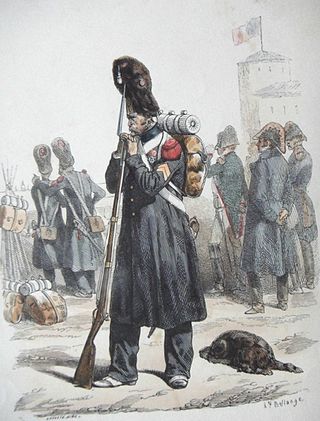
The Imperial Guard was originally a group of elite soldiers of the French Army under the direct command of Napoleon I, but grew considerably over time. It acted as his bodyguard and tactical reserve, and he was careful of its use in battle. The Guard was divided into the staff, infantry, cavalry, and artillery regiments, as well as battalions of sappers and marines. The guard itself as a whole distinguished between the experienced veterans and less experienced members by being separated into three sections: the Old Guard, Middle Guard and Young Guard. The Young Guard was virtually annihilated in the Battle of Krasnoi during the French invasion of Russia.

Cuirassiers were cavalry equipped with a cuirass, sword, and pistols. Cuirassiers first appeared in mid-to-late 16th century Europe as a result of armoured cavalry, such as men-at-arms and demi-lancers discarding their lances and adopting pistols as their primary weapon. In the later part of the 17th century, the cuirassier lost his limb armour and subsequently wore only the cuirass, and sometimes a helmet. By this time, the sword or sabre had become his primary weapon, with pistols relegated to a secondary function.
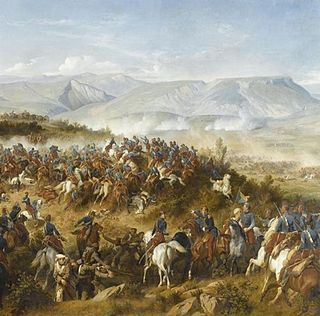
The Chasseurs d'Afrique were a light cavalry corps of chasseurs in the French Armée d'Afrique. First raised in 1831 from regular French cavalry posted to Algeria, they numbered five regiments by World War II. For most of their history they were recruited from either French volunteers or French settlers in North Africa doing their military service. As such they were the mounted equivalent of the French Zouave infantry. The other major cavalry element in the Armee d'Afrique were the Spahis—recruited from the indigenous peoples of Algeria, Tunisia, and Morocco with mostly French officers.

Chasseur, a French term for "hunter", is the designation given to certain regiments of French and Belgian light infantry or light cavalry to denote troops trained for rapid action.

The voltigeurs were French military skirmish units created in 1804 by Emperor Napoleon I. They replaced the second company of fusiliers in each existing infantry battalion.
This is an order of battle of the French and German Armies at the beginning of the Franco-Prussian War in 1870.
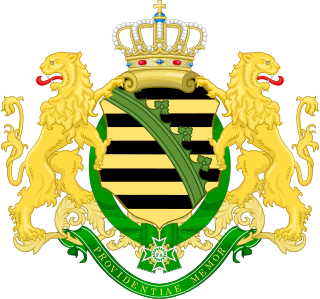
The Royal Saxon Army was the military force of the Electorate (1682–1807) and later the Kingdom of Saxony (1807–1918). A regular Saxon army was first established in 1682 and it continued to exist until the abolition of the German monarchies in 1918. With the formation of the Confederation of the Rhine by Napoleon the Royal Saxon Army joined the French "Grande Armée" along with 37 other German states.
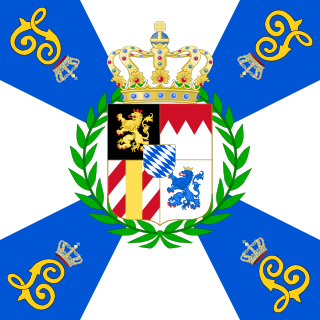
The Bavarian Army was the army of the Electorate (1682–1806) and then Kingdom (1806–1918) of Bavaria. It existed from 1682 as the standing army of Bavaria until the merger of the military sovereignty of Bavaria into that of the German State in 1919. The Bavarian Army was never comparable to the armies of the Great Powers of the 19th century, but it did provide the Wittelsbach dynasty with sufficient scope of action, in the context of effective alliance politics, to transform Bavaria from a territorially-disjointed small state to the second-largest state of the German Empire after Prussia.

In the Battle of Prenzlau or Capitulation of Prenzlau on 28 October 1806 two divisions of French cavalry and some infantry led by Marshal Joachim Murat intercepted a retreating Prussian corps led by Frederick Louis, Prince of Hohenlohe-Ingelfingen. In this action from the War of the Fourth Coalition, Hohenlohe surrendered his entire force to Murat after some fighting and a parley. Prenzlau is located about 90 kilometers north of Berlin in Brandenburg.

The Battle of Czarnowo on the night of 23–24 December 1806 saw troops of the First French Empire under the eye of Emperor Napoleon I launch an evening assault crossing of the Wkra River against Lieutenant General Alexander Ivanovich Ostermann-Tolstoy's defending Russian Empire forces. The attackers, part of Marshal Louis-Nicolas Davout's III Corps, succeeded in crossing the Wkra at its mouth and pressed eastward to the village of Czarnowo. After an all-night struggle, the Russian commander withdrew his troops to the east, ending this War of the Fourth Coalition action. Czarnowo is located on the north bank of the Narew River 33 kilometres (21 mi) north-northwest of Warsaw, Poland.

The Army of Châlons was a French military formation that fought during the Franco-Prussian War of 1870. Formed in the camp of Châlons on August 17, 1870, from elements of the Army of the Rhine which the formation was issued from, the Army of Châlons was engaged in combats of Beaumont and Sedan while disappearing during the capitulation of September 2, 1870.
The II Cavalry Corps of the Grande Armée was a French military unit that existed during the Napoleonic Wars. It was first formed in December 1806, but only enjoyed a brief existence under Marshal Jean-Baptiste Bessières. The II Cavalry Corps was reconstituted for the invasion of Russia in 1812 and commanded by General Louis-Pierre Montbrun who was killed in battle, as was his successor a few hours later. During the War of the Sixth Coalition, General Horace François Bastien Sébastiani de La Porta led the II Cavalry Corps in 1813, while General Antoine-Louis Decrest de Saint-Germain led the corps in 1814. During the Hundred Days, Emperor Napoleon Bonaparte raised the corps again and entrusted it to General Rémi Joseph Isidore Exelmans.
The VIII Corps of the Grande Armée was a French military unit that existed during the Napoleonic Wars. Emperor Napoleon I formed it in 1805 by borrowing divisions from other corps and assigned it to Marshal Édouard Mortier. Marshal André Masséna's Army of Italy was also reorganized as the VIII Corps at the end of the 1805 campaign. The corps was reformed for the 1806 campaign under Mortier and spent the rest of the year mopping up Prussian garrisons in western Germany.
The III Cavalry Corps of the Grande Armée was a French military unit that existed during the Napoleonic Wars. The corps was created in 1812 and reconstituted in 1813 and 1815. Emperor Napoleon Bonaparte first mobilized the corps for the invasion of Russia. Commanded by General Emmanuel de Grouchy, two divisions of the corps fought at Borodino, Tarutino, and Vyazma. A third division fought at the First and Second battles of Polotsk and the Berezina. During the War of the Sixth Coalition in 1813, General Jean-Toussaint Arrighi de Casanova led the corps at Großbeeren, Dennewitz, Leipzig, and Hanau.

The First Battle of Bar-sur-Aube was fought during the War of the Sixth Coalition when Marshal Édouard Mortier, duc de Trévise's corps of French Imperial Guards defended against an Austrians corps under Ignaz Gyulai and a Württemberger corps led by Crown Prince Frederick William of Württemberg. After holding his main defensive positions in stiff fighting, Mortier withdrew his elite troops during the night and retreated to Troyes. Bar-sur-Aube is located 53 kilometres (33 mi) east of Troyes.
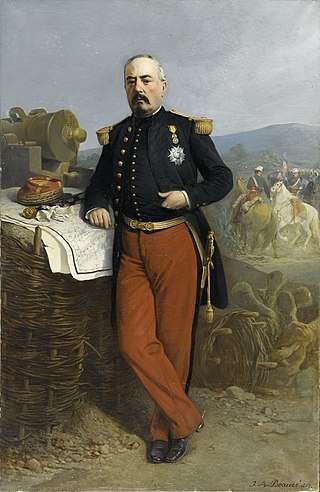
The Army of the Rhine was a French military unit that fought in the Franco-Prussian War. It was created after the declaration of war on July 18 1870.
A regiment de marche is a French temporary, regiment created for a specific campaign or other military purpose.

The Army of the Kingdom of Naples was the primary land defence and offence force of the Kingdom of Naples. It served alongside Napoleon’s Grande Armée in various campaigns and wars across Europe, until its final demise in the Neapolitan War of 1815. It was in service from 1806 to 1815, reborn from the Army of the Two Sicilies after the annexation of Naples. The Army was more known for the splendour of its uniforms rather than the achievements of its troops.
The French Imperial Army was the land force branch of the French imperial military during the Napoleonic era.